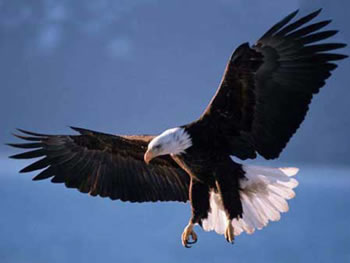by Dahir Wasame
Saturday, June 30, 2007
 This week, the conservationist around the world, most importantly here in America are celebrating the success efforts of bringing the Bald Eagle back from the brink of extinction. This was an effort that exemplifies one of America’s ingenuities in action, from enacting the Endangered Species Act, law enforcement, seeking the public support to establishing breeding programs that repopulated the American wilderness with the eagles.
This week, the conservationist around the world, most importantly here in America are celebrating the success efforts of bringing the Bald Eagle back from the brink of extinction. This was an effort that exemplifies one of America’s ingenuities in action, from enacting the Endangered Species Act, law enforcement, seeking the public support to establishing breeding programs that repopulated the American wilderness with the eagles.
Can you imagine that in 1963, there were 417 pairs of this bird?, moreover, they were all facing the same threat that made their numbers to dwindle that low. Wildlife experts attribute the causes of the destruction, mainly to habitat loss and DDT poison, the later was killing the eagles inadvertently, by softening the shells of their eggs. Auspiciously, today the number of the eagles are considered healthy, 10,000 pairs and counting and that is why this week the US Department of Interior had to de-list the eagles from the Threatened Species List. In addition the eagles are still protected by both Federal and State laws, this is all in order to prevent the eagles from the kind of crisis that was witnessed during the 1960s.
What does this mean for the rest of the world and places like Somalia, where important wildlife species are facing the same fate, or worse yet may be disappearing rapidly?. Knowingly, Somalia has recorded and identified over 250 species of mammals and close to 600 bird species , and this work is only superficial, when one considers Somalia being a unique place that has biodiversity that is not found elsewhere in the planet. Now given that, what are we doing to preserve this treasure that was privileged to us by nature?. Truthfully, the answer is may be not much now, but the American action toward their natural treasures, should be inspirational to our leaders, conservationist, and the public.
Historically, Somalia enacted many laws that were meant to protect it’s wildlife, among the notables laws are The Conservation of Fauna and Flora of 1969 and the 1971 law number 65 that banned all forms of hunting. But, all of these laws that we had, have no much affect on the ground. For instance the flag species such African Elephant’s estimated number of over 40,000 in the late 1970s were reduced to not more than 2000 in the late 1980s. However, Somalia’s world image was a country where the illegal wildlife trade, most importantly the elephant ivory and rhino horn poaching and illegal trade, went unchecked. But that was changed in the late 1980s. This happened when the Government of Somalia sought to stop the illegal ivory trade by cooperating with world conservation organizations such as Food and Agricultural Organization and CITES ( Convention for International Trade of Endangered Species). Good example of such cooperation was when in 1988 CITES World Conference focused on elephant trade and in response Somalia , with the assistance of our friends, proposed and passed an amendment that called for the total ban of elephant ivory trade. That is why CITES called it the Somali amendment at that time. Evidently, Somalia showed, if provided proper leadership and opportunity, that we can be amongst our peers, in terms of respecting international laws and standing up to be good stewards of the planet’s natural resources.
Never the less, the challenge is for the Somalis themselves and it’s how much can we do to preserve our natural resources, despite the violence and the lawlessness that even threaten our own existence as Somalis?. First of all, we must acknowledge the efforts that is being done by various entities, including the Somali Federal Government, all of the State governments and our brothers and sisters in Somaliland, for their courageous act of prohibiting the charcoal exportation and wildlife trade. In addition, we also have to recognize the conservation work that is being done by nongovernmental organizations, both local and international. Unfortunately, we are very far from where our colleagues are, both from the region and the world, as far as conservation of wildlife is concerned. We must do everything, whether it’s small or grand, that we can do to protect wildlife and these are the author’s areas of priority;
1) Immediate and total halt of illegal trade of our natural resources.
2) Conscious and tangible efforts by local authorities to stop the destruction of our natural resources.
3) Educating the public about the natural resources preservation for sustainable use.
4) Most importantly, the upcoming Somali Reconciliation (May Allah make it a successful one) meeting should recommend to both local and national authorities, to enforce the current laws that protect wildlife and areas of conservation importance.
In conclusion, this week’s celebration of Americans and the world of conservation for the successful work of repopulating the Bald Eagle, America’s national symbol, was felt all over the world. Doug Inkley, a senior scientist at the National Wildlife Federation summed it up this way “ It’s a man on the moon moment for wildlife”. Therefore, this moment might as well enlighten us to recognize that it’s not too late to act in preserving our wildlife resource for perpetual use and aim that one day we might celebrate a remarkable milestone for our national symbol, The African Leopard.
Dahir Warsame
Wildlife Biologist
[email protected]